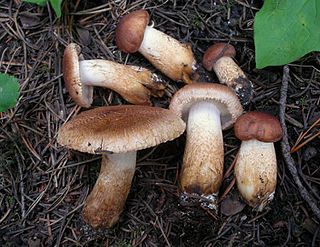Related Research Articles

Matsutake, Tricholoma matsutake, is a species of choice edible mycorrhizal mushroom that grows in East Asia, northern Europe, and North America. It is prized in Japanese cuisine for its distinct spicy-aromatic odor.

Tricholoma is a genus of fungus that contains many fairly fleshy white-spored gilled mushrooms which are found worldwide generally growing in woodlands. These are ectomycorrhizal fungi, existing in a symbiotic relationship with various species of coniferous or broad-leaved trees. The generic name derives from Ancient Greek: τριχο-, romanized: tricho-, lit. 'hair' and Ancient Greek: λῶμα, romanized: loma, lit. 'fringe, border' although only a few species have shaggy caps which fit this description.

Tricholoma equestre or Tricholoma flavovirens, commonly known as the man on horseback or yellow knight is a widely eaten but arguably toxic fungus of the genus Tricholoma that forms ectomycorrhiza with pine trees.

Tricholoma pardinum, commonly known as spotted tricholoma, tiger tricholoma, tigertop, leopard knight, or dirty trich, is a gilled mushroom widely distributed across North America, Europe, and parts of Asia. It is generally found in beech woodland in summer and autumn. Two subspecies have been described from southern Europe. First officially described by Christiaan Hendrik Persoon in 1801, T. pardinum has had a confusing taxonomic history that extends over two centuries. In 1762, German naturalist Jacob Christian Schäffer described the species Agaricus tigrinus with an illustration corresponding to what is thought to be T. pardinum, and consequently, the name Tricholoma tigrinum has been used erroneously in some European field guides.

Tricholoma terreum, commonly known as the grey knight or dirty tricholoma, is a grey-capped mushroom of the large genus Tricholoma. It is found in coniferous woodlands in Europe, and has also been encountered under introduced pine trees in Australia and New Zealand. It is regarded as edible. A 2014 article speculated that it may be poisonous, but Sitta et al. in 2016 published in the same journal a counter article demonstrating the unfounded nature of such speculation.

Tricholoma saponaceum, also known as the soap-scented toadstool, soapy tricholoma, soapy knight or soap tricholoma is an inedible mushroom found in woodlands in Europe and North America.

The Hørdum stone is a Viking Age picture stone discovered in Hørdum, Thisted Municipality, North Denmark Region, Denmark, that depicts a legend from Norse mythology involving the god Thor and Jörmungandr, the Midgard serpent.

Tricholoma portentosum, commonly known as the charbonnier, streaked tricholoma, or sooty head, in North America, is a grey-capped edible mushroom of the large genus Tricholoma. It is found in woodlands in Europe and North America.

Tricholoma myomyces is a mushroom of the agaric genus Tricholoma, usually considered to be a synonym of Tricholoma terreum. The species was first described scientifically by Christian Hendrik Persoon in 1794 as Agaricus myomyces, and later transferred to the genus Tricholoma by Danish mycologist Jakob Emanuel Lange in 1933. It is found in Europe and northern North America.

Tricholoma vaccinum, commonly known as the russet scaly tricholoma, the scaly knight, or the fuzztop, is a fungus of the agaric genus Tricholoma. It produces medium-sized fruit bodies (mushrooms) that have a distinctive hairy reddish-brown cap with a shaggy margin when young. The cap, which can reach a diameter of up to 6.5 cm (2.6 in) wide, breaks up into flattened scales in maturity. It has cream-buff to pinkish gills with brown spots. Its fibrous, hollow stipe is white above and reddish brown below, and measures 4 to 7.5 cm long. Although young fruit bodies have a partial veil, it does not leave a ring on the stipe.

Tricholoma ustale, commonly known as the burnt knight, is a species of mushroom in the large genus Tricholoma. It is found in Asia, Europe, and North America, though those from North America may represent one or more different species.

Tricholoma cingulatum is a mushroom of the agaric genus Tricholoma. First described in 1830 as Agaricus cingulatus by Elias Magnus Fries, it was transferred to the genus Tricholoma by Almfelt in 1830.

Tricholoma colossus is a mushroom of the agaric genus Tricholoma. Due to its ringed foot, it was previously classified as Armillaria, even though it is otherwise clearly Tricholoma. The cap is 6–30 cm wide, brick red to chestnut brown, hemispherical when young, widening later on, uneven, always with very thick flesh, surface slightly sticky, developing somewhat into scales. The stipe is thick, 2–5 cm thick, solid. Ring-like formation at the top of the foot, above which it is white. Grows in pine forests to September to October; very rare.

Tricholoma pessundatum is a mushroom of the agaric genus Tricholoma. First described as Agaricus pessundatus by Elias Magnus Fries in 1821, it was transferred to the genus Tricholoma by Lucien Quélet in 1872.

Tricholoma pullum is a mushroom of the agaric genus Tricholoma. Described as new to science in 1989, it is found in eastern North America.

Tricholoma sejunctum is a mushroom that appears across much of the Northern Hemisphere and is associated with pine forests.

Inocybe rimosa, commonly known as straw-colored fiber head, is a poisonous mushroom native to Europe. Its toxic ingredient is muscarine, discovered during the 1930s. Serious poisoning can result from consuming any quantity of the mushroom.
References
- ↑ Quélet L. (1872). "Les Champignons du Jura et des Vosges". Mémoires de la Société d'Émulation de Montbéliard (in French). 5 (2): 43–332 (see p. 232).
- ↑ "Tricholoma hordum (Fr.) Quél. :232, 1872". MycoBank. International Mycological Association. Retrieved 2013-03-23.